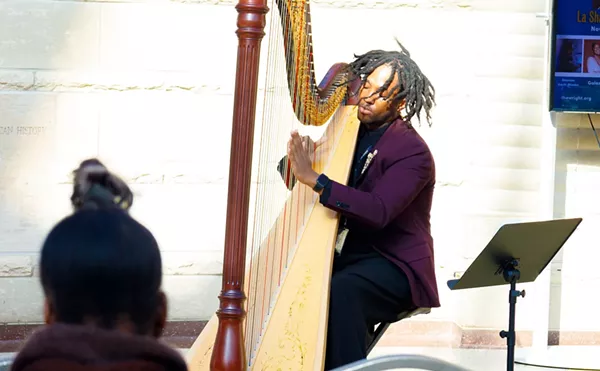
Audio By Carbonatix
[
{
"name": "GPT - Leaderboard - Inline - Content",
"component": "35519556",
"insertPoint": "5th",
"startingPoint": "3",
"requiredCountToDisplay": "3",
"maxInsertions": 100,
"adList": [
{
"adPreset": "LeaderboardInline"
}
]
}
]
By Ashley Zlatopolsky
If I had a nickel for every time I heard, “Wow, I never knew Detroit was this much fun!” I’d probably have enough money to cover my bar tab for at least three nights. Which is a lot, considering a night out in Detroit can start anywhere around 10 p.m. and go through 10 a.m. the following morning. Yeah, yeah bars close at 2 a.m., unless you’re in Detroit, where places like The Works run late and after-hours tucked away in the deep recesses of the city (such as abandoned meatpacking warehouses in Southwest and secret dusty loft spaces above restaurants downtown) blare beats until no one left standing is capable of throwing down music. And no matter how filthy or obscure the location, people would always show up.
Whenever friends from out of town visited Detroit for the first time, I generally witnessed one of three reactions when I took them to these places: they were either a) shocked by the grime, b) shocked by the level of partying in clubs and afterhours that ran until the birds chirped, or c) shocked at having some of the best times of their lives. And if done correctly, all three reactions happened simultaneously.
I remember the first time I went out in Detroit and had these same experiences. I mean, REALLY went out in Detroit. I was young, dressed nice, and didn’t know what the hell to expect. I had only gone out in cities like Chicago, Miami and Vegas—bottle-service meccas, if you will. Bro paradises, where the majority of people wore cut-off tanks with gold chains, reeking of either overly expensive cologne or embarrassingly cheap cologne that would have been better off left on daddy’s counter. If you didn’t know a promoter or look sexy, you were stuck shelling out $40 at the door for mediocre talent and another $100 on five watered-down drinks. Sure, good music and good venues existed (and continue to exist) in those cities, along with varied after hours, but one had to search to escape the quickly over-saturating “EDM scene” — and it wasn’t the same. Detroit was the first city I went out in, and is still the only city, where the underground overshadowed the mainstream. It was the only city where overdressed patrons were out of place, and those in jeans and a t-shirt fit in best.
The morning after my first “real” Detroit outing, I came home drenched in sweat from dancing in a stuffy fifth floor warehouse space with no air conditioning in the middle of July. The clothes on my back were encompassed by the smell of stale cigarette smoke and spilled beer. My nose was filled with black soot from the mass amounts of dust and dirt floating through the air, my eyes sore from staring at a dimly lit DJ spinning equally dark techno, illuminated by a single lamp, my ears ringing from standing next to a shitty speaker for six hours. For the life of me, I cannot remember the location (including how I ended up there) or who was playing, but I do remember truly dancing for the first time—and this is coming from someone who danced semi-professionally for 16 years. And I remember having the first “best night of my life,” which was followed by another consecutive 100 “best nights of my life” as I continued to immerse myself in Detroit’s vibrant—yet still obscured—techno and underground music culture.
It was a beautiful awakening. I discovered the gems of the city, where I could pay (usually) less than $10 cover, where local DJs held more talent in their pinky fingers than 20 bigger international artists combined. Where most security guards weren’t dogs and drinks were beyond reasonably priced. Where dirt and dust and grime and filth described the surroundings in the most beautiful way. Where we danced the nights away in Detroit’s most historical—yet unfortunately sometimes abandoned—buildings, places where music history was made (and continued to be made) with our communal involvement. Where there was something special about seeing the same familiar faces at venue after venue, year after year, cheering on friends spinning, making the music sound that much better. There was this energy in Detroit I had never felt before, an energy I have yet to find elsewhere in the world, an energy, after being in places such as Berlin and Brooklyn, that STILL couldn’t be matched.
And when people visit Detroit, they feel that same energy.
Detroit, to outsiders and occupants alike, is this run-down (and still lovely), do-it-yourself playground for music and art where, literally, anything can happen. People who visit the city recognize this atmosphere right away. It’s a creative zone, a magnet for unordinary occurrences and bizarre experiences that probably wouldn’t—and couldn’t—occur elsewhere. It’s a goldmine of cultural treasure, in such abundance that it will never be fully uncovered and disclosed to the general public. That’s what makes Detroit so appealing, particularly its music; it leaves people aching to come back and discover more, more of the infinite talent, to experience that same shocking thrill, to fall in love with the city’s secrets again and again.
I’ve seen out-of-towners look at photos of Detroit staples (and after-hours, if taken) and say, “What the hell?” One creaky bathroom stall for 800 people, ready to collapse in on itself any minute, paint-chipped walls, questionable cups of water at the bar filled from sources better left unseen, sweat-soaked crowds. I mean, just absolutely fucking disgusting. And when they got to experience it for themselves, they couldn’t get enough—and neither could I. Something about the lack of structure, the spontaneity, the freedom, the raw and unbridled environment, yet still, the collectiveness of Detroit’s underground culture, drew these people in (plus myself years back)and became desirable.
We were part of one of the world’s best-kept—and coolest—secrets.





